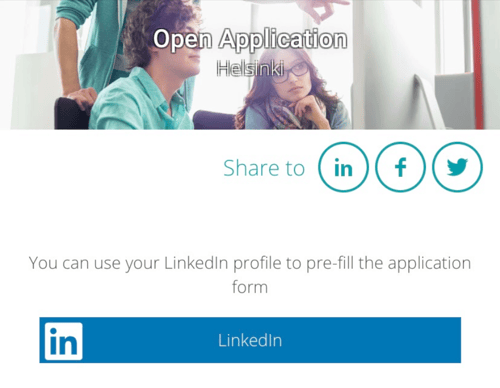
Jan Söderström

We now use our mobile devices for nearly everything. We use them to browse through and post on social media platforms, order food, book plane tickets, stream the latest episodes of our favorite shows on Netflix, … or even look for new job opportunities. In fact, according to Glassdoor, a whopping 58% of job seekers are looking for jobs from their phones.
A common misconception is to believe that millennials (and younger generations) are the only ones using their mobile devices to seek career opportunities online. It is not true. Indeed reveals that mobile job search isn’t just for millennials. It cuts across generations.
In the US, 78% of millennials, 73% of Gen Xers, and 57% of baby boomers have reportedly used mobile job search. This means that recruiters need to design a polished mobile recruitment process to keep providing a positive candidate experience.
Of course, there’s an issue. The recruitment marketing platform developer SmashFly revealed that only 35 percent of Fortune 500 companies have mobile-friendly careers sites (we’ll confirm this later in this blog post with an example from a major institution).
“The same way businesses are optimizing their processes, products, and services to match what their audience wants, they need to optimize the experience for candidates to stay attractive on the job market. In 2020, this also means optimizing the mobile candidate experience.”
–Jussi Luhtasela, CEO at Recright
In this blog post, I’ll explain why mobile recruitment optimization matters and share a couple of tips to help you improve your current mobile hiring experience.
Click to jump on the desired section.
Mobile recruitment candidly refers to the hiring process through the use of mobile devices. Naturally, and based on the statistics above, a non-mobile-friendly hiring process can be a great burden for businesses, as they could rule out top talent.
Given the mobile-unfriendliness of most career sites, Glassdoor reveals that mobile candidates usually complete 53% fewer applications and take about 80% longer to complete them, when they do.
On the other hand, mobile-friendly hiring processes attract candidates. A mobile-friendly job ad (and overall hiring process) can increase the number of candidates by as much as 11.6%.
In a competitive market, a mobile-friendly hiring process is, therefore, a powerful way to attract talent - at the expense of employers whose hiring processes aren’t optimized for a mobile usage.
“The harsher the experience for candidates, the less likely they are to apply, thus making your candidate pool a lot smaller.”
–Miikka Tuomola, Business Development Director at Recright
In this post, we’re suggesting 4 ways for recruiters to make their hiring processes more attractive for mobile job seekers. Starting with the most obvious one: optimizing their career site for mobile users.
Your businesses’ entire performance could be affected if your website isn’t mobile optimized. Did you know that mobile makes up for more than half of the searches on Google? Or that Google now penalizes domains that aren’t mobile-friendly?
This matters even more so because more than 1 in 2 internet users (give or take) use their mobile devices to browse the web. StatCounter indeed reveals that mobile makes up for 53.29% of the world’s web traffic (with significant regional disparity).

Moreover, candidates are 5 times more likely to leave a website that isn’t mobile-friendly.
There’s nothing like an illustrated example to convey an idea. I googled “UN Careers” and visited their website from my phone. Here’s what happened.
Sadly, the website isn’t not built at all for mobile users. Note that I was browsing from a fairly large phone (iPhone 11) and yet, navigating on the desktop version of the page was a nightmare.
On the other hand, here’s a well-crafted mobile experience from our customer Netflix’s careers site.
The difference between the two is striking. The candidate experience is very much altered from the UN’s messy interface to Netflix’s sleek website.
Not all mobile users are tech-savvy enough to leverage cloud hosting solutions and share documents such as saved PDFs directly from their phones. Besides, the fact that recruiters don’t spend more than 6 seconds on a CV raises a serious question: should you bypass CVs and cover letters altogether from your application process?
This is something that we (at Recright) are applying to our own recruitment. We let candidates identify themselves via their LinkedIn profile and only require them to share a phone number. Candidates are then free to attach a CV and cover letter, but it’s not a requirement.

Forget about mobile apps. Instead, focus on building a mobile-friendly career site.
"The most important thing is that the employer's career site is mobile-friendly"
–Matt Bernardo, Mobile product manager at Monster.
Developing a dedicated mobile application comes with a lot of things to take into account, including:
What’s more, we believe that making candidates download an app can be redundant and, therefore, increases the risk of losing them from the very beginning of your application process.
The ideal scenario should allow candidates to navigate through your entire hiring process from the device of their choosing, may it be a desktop or a mobile device, without having to download and install anything extra. This type of feature is necessary to offer a spotless mobile experience and only advanced recruitment platforms such as Recright provide it, relying on video interviews.
With a Recright-like recruitment browser-based platform, candidates can apply to job ads and participate in video interviews from their mobile devices, at any time, from anywhere. Here’s how it looks:
And voilà. From a candidate perspective, it doesn’t get more simple than that. Note that you can also use the same technology to invite pre-selected candidates to answer your pre-recorded video interview questions at later stages.
According to our client JYSK, managing the entire recruitment process through mobile is crucial for both candidates and recruiters. Today, 70% of their candidates access their job ads from a mobile device.
What’s more, optimizing your hiring process for mobile also makes it a lot shorter. This is crucial as reducing the time needed to complete a job application by 10% results in a 2.3% increase in applications from mobile users and a 1.5% increase in applications from desktop users.
Why does it matter? We now know that a majority of social media users are only using their mobile devices to browse social platforms.
Social media is one of the most efficient channels to communicate with your audience, partners, and prospective candidates… if you know how to reach the right people. Here are our top tips.
Mainstream social media platforms make it easy for brands to share their messages across the globe. Having said that, when everybody is talking at the same time, using the same codes, individual messages quickly become inaudible.
To become audible and visible to prospective mobile candidates on social media, recruiters need to eliminate the noise. They need to find the right conversations to take part in.
Be where your ideal candidates are
If you want as many eyeballs on your job openings, you don’t want to spend too much time screening hundreds of bad-fit candidates.
While LinkedIn is certainly the most renowned professional social platform, your prospective candidates may not be actively using it. Based on the position you're recruiting for, it might be better for you to rely on Instagram, Reddit, or even Behance if you’re trying to hire creative talent.
Use specific hashtags
Hashtags can boost your posts’ visibility…or drown them in the noise. If you publish a job ad on Twitter and only include hashtags such as #Jobs or #Hiring, you’ll be competing with all the other recruiters around the globe, using the same communication technique.
If you’re hiring a marketer, for example, don’t rely on generic and overused hashtags such as #Marketing. Instead, consider using #MarketingJobs.
Better even, use hashtags to reveal the location you’re hiring for. This will drastically help job seekers to identify your post. Here are a couple of winning examples, from a job seeker’s perspective.

Finally, social media is a formidable tool to promote your company culture.
It is a window to share content to show what makes you unique, and how it feels to work for your company. Besides, people love talking about businesses with unique working cultures, thus getting more eyeballs on your job openings.
Here are two examples that I particularly liked.
The first one is a company video from Zendesk. It presents Zendesk, what it does and why it does it, and, most importantly, it puts people forward.
After watching the video, you’ll know what really makes Zendesk so unique: its people.
Why does it matter to share video content to promote your company culture and employer brand to mobile users? Simple. More than 70% of YouTube watch time comes from mobile devices.
|
To learn more on the topic, read our dedicated guide to create a powerful company culture video. |
My second winning example comes from Oatly’s Instagram account.
As they were looking for someone to “write crazy good copy in English”, Oatly shared the following post on Instagram.
To apply, Oatly specifically asked not to send any “CV, email or PDF cover letter with business recommendations from LinkedIn friends”. Instead, they asked prospective candidates to write an Instagram post using the hashtag #iwannawrite4oatly.
A bold move that perfectly depicts the creative mindset of the whole company.
The objective is to make the communication process smoother both for recruiters and candidates. As an example, did you know that text messages see a 98% open rate, compared to 20% for email?
Including a text messaging application in your hiring process has a lot of perks:
Our mobile phones are never far. Sending text messages allows recruiters to communicate fast and ensure that their messages are seen by candidates.
To this day, most recruiters tend to rely on more traditional channels to update their candidates. Doing so, you could make your company look more approachable and stand out from the competition.
Responding to emails and answering phone calls can be particularly complicated for employed job seekers. On the other hand, answering text messages shouldn’t raise any suspicion from colleagues and managers.
Note that you can send text messages using Recright to update candidates about the next step of your hiring process, and/or remind them about a scheduled interview. We tell you more about this here.
Now, text messages can be perceived as quite impersonal when used alone. Using Recright, recruiters can record and send personalized videos to candidates to update them.
One last tip before you go?
Mobile is here to stay. From now on, make sure that everything you implement in your hiring process - may it be a chatbot or a new career site - is also compatible with mobile devices.
That’s it! You now know everything you need to know about mobile recruitment, why it matters, and how to optimize the candidate experience for your mobile candidates.
If you have any other tip you’d like to share with fellow recruiters, leave a comment!
If you’d like to discover how Recright can improve your candidate experience both for desktop and mobile candidates, let’s book a demo together!
Get recruitment insights, tips, and best practices delivered to your inbox monthly!